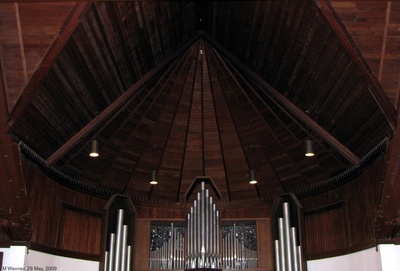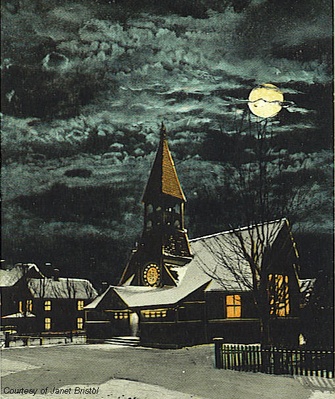 The First Presbyterian Church of Saranac Lake, 1901
The First Presbyterian Church of Saranac Lake, 1901
Address: 57 Church Street
Old Address: 23 Church Street
Year built: 1880
Adirondack Daily Enterprise, July 14, 1990
Church and town grow together in first 100 years
By SUSAN COLT Enterprise Staff Writer
SARANAC LAKE — The First Presbyterian Church will be celebrating its first 100 years on Sunday, July 22.
In July of 1932, the 42nd anniversary, the church published a small year book containing a brief history and letters to the parish from early ministers. As the book makes clear, from very early on the church and the health industry established here were intertwined. Two of the earliest ministers were living here because their wives had tuberculosis.
According to the anniversary book, "The immediate task of the church in this community is to be a friend to those who came here to regain their health."
The church held its first organizational meeting on July 25, 1890, when, "Twelve persons were received by letter from the Presbyterian Church of Black Brook and five on profession of faith."
The organizational service was held in the church, still so new that it had no windows and only long wooden benches for seats, but regular meetings for worship were held in the town hall and other buildings until 1893 when the church was completed.
The building process was helped along by Col. Eliot Shepard, for whom Shepard Avenue here is named, who assumed the $900 church debt, paid for a manse, built a stable and donated the Church bell. Shepard was a son-in-law of William H. Vanderbilt.
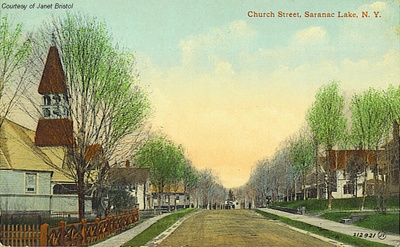 Church St. First Presbyterian Church on left
Church St. First Presbyterian Church on left
Costs were low in the early days when the pastor's annual salary was $954.64 and three months of electricity (in 1905) cost $2.25.
The early history contained painful conflicts as well, as the description of the minister, Roy Chamberlain and his subsequent anniversary letter to the book publisher illustrate.
"In 1915 Rev. Roy Chamberlain, a young man of exceptional vigor and strength, interested in athletics and in a radical application of the Gospel to life, became the pastor. He was very popular with the young people, among whom he did splendid work."
But the description continues, "He was minister during the trying days of the war and suffered intensely because of his pacifistic attitude which he believed to be the only Christian one. In 1918, however, he went as a chaplain to France. For a year or more after he returned he was broken in health but fully recovered....His sincerity, courage and Christian attitude are appreciated much more now by the people of the church than during the days of war fever."
What must have been a difficult time for a young minister and his flock is referred to by Chamberlain in his letter as follows: "May I express once more my gratitude for your patience and indulgence with a raw, untried youngster whom you called to minister to your Church in July, 1915. A fresh graduate from a theological school has to learn somewhere but his first years of "practice" are often hard on his people. Good intentions and unbounded enthusiasm are no substitute for the wisdom and growing spirituality which only experience can bring. It was with you and from you that I began to know what a life with our Master might mean."
During these years of change and growth, the Presbyterian Church was also growing. By 1932, the church had 350 members, a handful from distant places, but most of the members were local visitors.
The tuberculosis health industry continued to shape the nature and character of the church. The Reverend Hiram W. Lyon, minister of the church in 1932 had come to Saranac Lake for his health in 1925. So much time was spent in ministering to people in cure cottages that in 1928 a parish visitor, Miss Christine Burdick, was hired. Miss Burdick was a graduate of the Boston University School of Religious Education and Social Work. In 1928, she made 2,000 home visits.
Women of the church formed their first missionary society in 1896 and pledged two cents a week at first — later it was raised to a mandatory 25 cents a month. The money, which soon took the form of voluntary pledges, was sent to foreign missions.
Young people also formed groups to raise money for the less fortunate. One such group "The Francis Willard Mission Club" remembers an Alaskan girl who came to Saranac Lake to cure.
The village, with a residential downtown shaded by large maples in the 1890s, grew rapidly through the 30s as people from far and wide came in search of health. Church Street, however, in a 1897 photo, appears virtually treeless in the winter, the round church window dominant then as it is now.
President Calvin Coolidge worshiped here in the summer of 1926, while White Pine Camp on Osgood Pond served as the summer white house. His letter in the 1932 book says, "Mrs. Coolidge and I are connected with the Congregational Church, but we think it more important to attend a place of divine worship on Sunday morning, than to insist on our own church...We shall always remember the kindness with which the church received us and a great satisfaction in the good which we believe it is doing."
The front porch, first enclosed with glass in 1917, was made into an office and chapel in 1967. A pipe organ installed in 1925, (President Coolidge remarked that the music was particularly fine) was replaced in 1973 with a specially built Holtkamp pipe organ given by Mrs. Ralph Burger. The organ is modeled after 17th and 18th century German organs and is especially suited to baroque music. Mrs. Burger gave the organ in memory of her husband, chairman of the board of A&P, who had a camp in the area.
The most noticeable change was the removal of the bell and belfry. Upon removal, the bell was given to North Country Community College in 1967 for the campus buildings then in the planning stage. The bell was returned in 1977 as the college had never used it and installed in a tower at the side of the church in memory of Miles and David Feree.
The Christian Education Building called Gurley Hall in memory of the Reverend Alvin Gurley past for 20 years is razed and a new, two-story addition at the rear of the church takes its place.
The church has always provided a warm, spiritual home for its members and individual members have witnessed by taking an active part in every phase of community life.
From the beginning the church has emphasized the importance of religious education — since 1956 it has sponsored or housed a nursery school. In 1928, a Boy Scout Troop was formed, which by 1932 boasted of eight Eagle Scouts. It housed the first senior citizens and youth centers and provided meeting space for dozens of other organizations.
The church will celebrate its first 100 years in Saranac Lake with a worship service, dedication of new hymnals, singing of old songs, interment of a time capsule, awarding of prizes and, finally, a picnic.
Sources:
- National Register of Historic Places Registration Form
- Colt, Susan, Adirondack Daily Enterprise, July 14, 1990, "Church and town grow together in first 100 years."

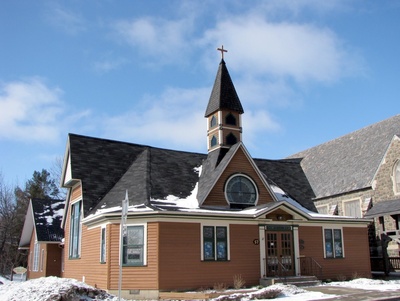 First Presbyterian Church of Saranac Lake, 2/28/2009
First Presbyterian Church of Saranac Lake, 2/28/2009
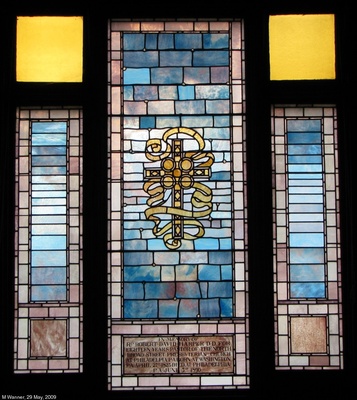 In memory of Rev. Robert David Harper D D, for eighteen years pastor of the North Broad Street Presbyterian Church at Philadelphia Pa. Born at Washington, Pa, April 27th, 1825. Died at Philadelphia, Pa, June 3rd, 1890.
In memory of Rev. Robert David Harper D D, for eighteen years pastor of the North Broad Street Presbyterian Church at Philadelphia Pa. Born at Washington, Pa, April 27th, 1825. Died at Philadelphia, Pa, June 3rd, 1890. 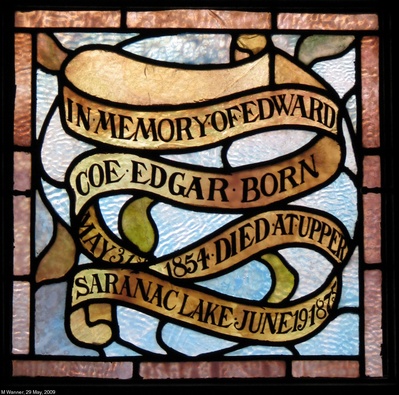 In Memory of Edward Coe Edgar. Born May 31st, 1854. Died at Upper Saranac Lake June 19, 1875.
In Memory of Edward Coe Edgar. Born May 31st, 1854. Died at Upper Saranac Lake June 19, 1875. 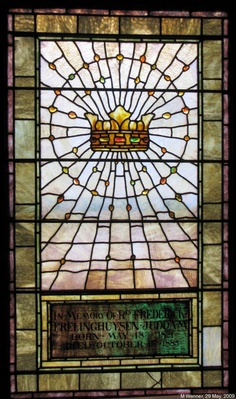 In memory of Rev. Frederick Frelinghuysen Judd A M, born May 18th, 1821, died October 6th, 1885.
In memory of Rev. Frederick Frelinghuysen Judd A M, born May 18th, 1821, died October 6th, 1885.
In her article titled "Missions Accomplished: Richard McCarthy's Church-Building Spree" in Adirondack Life, August 2004, Sally E. Svenson describes these windows in the Presbyterian Church as "simple Tiffany stained-glass windows (memorializing his own friends and Presbyterian heroes)."
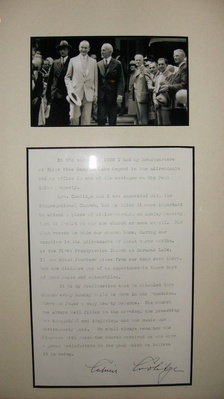 Calvin Coolidge History. Coolidge is in the white suit. The man to the right of Coolidge is the Reverend Charles Erdmann
Calvin Coolidge History. Coolidge is in the white suit. The man to the right of Coolidge is the Reverend Charles Erdmann 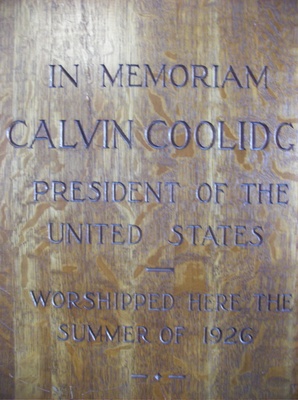 Calvin Coolidge History, First Presbyterian Church of Saranac Lake, 3/1/2009
Calvin Coolidge History, First Presbyterian Church of Saranac Lake, 3/1/2009  Calvin Coolidge History, First Presbyterian Church of Saranac Lake, 3/1/2009
Calvin Coolidge History, First Presbyterian Church of Saranac Lake, 3/1/2009
Malone Farmer, November 10, 1909
Rev. George Roberts, Jr., is to be installed pastor of the First Presbyterian church at Saranac Lake this (Tuesday) evening. The sermon will be preached by Rev. John T. Dallas, of Waterbury, Conn. The charge to the pastor will be given by Rev. John A. Macintosh, of Malone, and the charge to the people by Rev. William C. Taylor, of Keese's Mills.
Adirondack Daily Enterprise, November 1952
Committees Named For Xmas Bazaar
The annual Christmas Bazaar, sponsored by the Women's League of the Presbyterian Church, will be held Saturday at the church house. Attractive needle work, aprons, gifts and food will be on sale from 10 a.m. to 9 p.m. Tea will be served. The following committees are assisting with arrangements: Fancy Work—Mrs. Hugh Kinghorn, Mrs. Daniel Brumfiel, Mrs. F. D. Leggett, Mrs. Janssen, Mrs. Isabella Shannon, Mrs. James Monroe, Mrs. F. Clark White and Mrs. Berkeley Zinn. Aprons—Mrs. William Cardy, Mrs. Robert Zellweger, Mrs. Fred Hollis and Mrs. James Premo; Food Table—Mrs. Charles Roberson, Mrs. Floyd Downs, Mrs. Leonard Houghton, Mrs. Arthur Buck, Mrs. D. S. McCrum, Mrs. Earl Smith and Miss Jean Conklin. Gift Table—Mrs. Oscar Worthen, Mrs. Robert Derrick, Mrs. Ernest Baldwin and Miss Florence Leonard. Tea Table—Mrs. James MacIntyre, Mrs. Homer McCreary, Mrs. Milo Otis, Mrs. Lupino and Miss Susan Cahill. Mrs. William A. Jeffrey is general chairman. A cordial invitation is extended to the public.
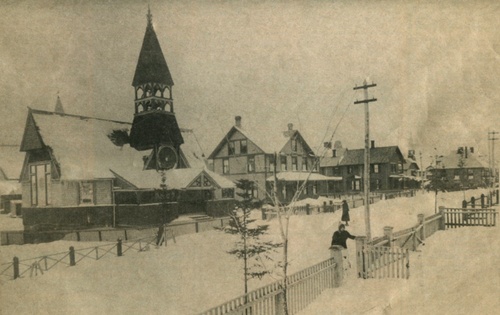 First Presbyterian Church of Saranac Lake, 1897 (Watertown Daily Times, 1948) Watertown Daily Times, 1948 1 PRESBYTERIAN CHURCH—The Saranac Lake Presbyterian church is shown in the left foreground of the above picture taken in the winter of 1897 by the local photographer of that time, George Baldwin.
First Presbyterian Church of Saranac Lake, 1897 (Watertown Daily Times, 1948) Watertown Daily Times, 1948 1 PRESBYTERIAN CHURCH—The Saranac Lake Presbyterian church is shown in the left foreground of the above picture taken in the winter of 1897 by the local photographer of that time, George Baldwin.
Built in the early 1900s by the leading contractor of the area, A. S. Wright, the building was the third church on the street which has become known as Church street.
The first pastor of the church was a Rev. Mr. McCarthy who died in later years at 24 Front street.
The building at 24 Front street, which is now known as the Stearns Cottage was built by a veteran of the Civil war, a Colonel Shepard, a devout Presbyterian, who designed the building to be used as a Presbyterian Manse. Shepard avenue, a street in the village, was named after the Civil war veteran.
Next to the Presbyterian church is the Methodist parish house, which today is the home of the Rev. Theodore R. Bundy, pastor of the church which stands on the site of the above parish house. The parish house has been moved to the rear of the church.
Although it is hardly perceptible in the above photo, St. Bernard street separates the Methodist parish house from the building on the right of it. This building, built by Miss Ada Murray in the early days of the village is now the home of Dr. Anthony B. Gedroiz, Saranac Lake Health officer.
The original Catholic church in the village can be seen at the extreme left of the picture. This church burned many years ago and was supplanted by a modern stone church.
On the extreme right of the photograph is the Saranac Laboratory. Built as a research center under the direction of Dr. Edward Livingston Trudeau. On the left of the laboratory is the steeple of the original Methodist church which now houses the Independent Order of Odd Fellows.
Malone Farmer, October 28, 1903
The installation of Rev. John Bailey Kelly as pastor of the Presbyterian church at Saranac Lake occurs at that place this Tuesday evening, conducted by a committee of the Presbytery of Champlain, which comprises Rev. J. H. Gardner, of Fort Covington; Rev J. A. Macintosh, of Malone and Rev. William B. Lusk, of Paul Smith's.
Pastors:
-
Reverend Richard G. McCarthy, July 25, 1890 to August 1, 1893
-
Reverend Henry A. Lewis, Fall 1893 to October 1894
-
Reverend W. Armitage Beardsley, October 1894 to September 15, 1897
-
Reverend William Tatlock, September 1897 to Fall 1902
-
Reverend Dr. Edwin H. Dickinson, September 1902 to March 1903
-
Reverend John Bailey Kelly, D.D., 1903-1908
-
Reverend George Roberts, Jr., D.D., 1909-1915
-
Reverend Roy B. Chamberlin, 1915-1918
-
Reverend Mr. George Kennedy Newell, 1917-1926
-
Reverend Hiram W. Lyon, 1926-1937
-
Reverend Alvin B. Gurley, 1937-1957
-
Reverend W. James Erdmann, 1958-1963
-
Reverend Alexander Morrison, 1964
-
Reverend Lawrence F. Selig, 1965-1970
-
Reverend Dr. Phillip W. Zebley, 1971-1978
-
Reverend John R. McClester, 1978-1984
-
Reverend James L. Mechem, 1985-1992
-
Reverend Jesse Corum 1993 (perhaps as interim pastor)
-
Reverend Charles Monts, 1993-2002
-
Reverend Joann White, 2005
Parish Visitor:
-
Miss Christine Burdick, 1928-1934
Footnotes
1. For more information on this photograph and caption, see Old Saranac Lake photographs



